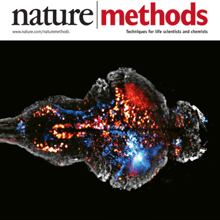Filter
Associated Lab
- Ahrens Lab (64) Apply Ahrens Lab filter
- Aso Lab (1) Apply Aso Lab filter
- Branson Lab (1) Apply Branson Lab filter
- Fitzgerald Lab (1) Apply Fitzgerald Lab filter
- Freeman Lab (5) Apply Freeman Lab filter
- Harris Lab (2) Apply Harris Lab filter
- Jayaraman Lab (2) Apply Jayaraman Lab filter
- Johnson Lab (1) Apply Johnson Lab filter
- Keller Lab (5) Apply Keller Lab filter
- Lavis Lab (3) Apply Lavis Lab filter
- Liu (Zhe) Lab (1) Apply Liu (Zhe) Lab filter
- Looger Lab (7) Apply Looger Lab filter
- Pedram Lab (2) Apply Pedram Lab filter
- Podgorski Lab (3) Apply Podgorski Lab filter
- Schreiter Lab (4) Apply Schreiter Lab filter
- Shroff Lab (2) Apply Shroff Lab filter
- Svoboda Lab (4) Apply Svoboda Lab filter
- Turaga Lab (2) Apply Turaga Lab filter
- Turner Lab (2) Apply Turner Lab filter
- Wang (Shaohe) Lab (2) Apply Wang (Shaohe) Lab filter
- Zlatic Lab (1) Apply Zlatic Lab filter
Associated Project Team
Publication Date
- 2025 (4) Apply 2025 filter
- 2024 (9) Apply 2024 filter
- 2023 (4) Apply 2023 filter
- 2022 (4) Apply 2022 filter
- 2021 (2) Apply 2021 filter
- 2020 (4) Apply 2020 filter
- 2019 (5) Apply 2019 filter
- 2018 (4) Apply 2018 filter
- 2017 (2) Apply 2017 filter
- 2016 (7) Apply 2016 filter
- 2015 (3) Apply 2015 filter
- 2014 (3) Apply 2014 filter
- 2013 (5) Apply 2013 filter
- 2012 (1) Apply 2012 filter
- 2011 (1) Apply 2011 filter
- 2010 (1) Apply 2010 filter
- 2008 (3) Apply 2008 filter
- 2006 (2) Apply 2006 filter
Type of Publication
64 Publications
Showing 61-64 of 64 resultsAs animals adapt to new situations, neuromodulation is a potent way to alter behavior, yet mechanisms by which neuromodulatory nuclei compute during behavior are underexplored. The serotonergic raphe supports motor learning in larval zebrafish by visually detecting distance traveled during swims, encoding action effectiveness, and modulating motor vigor. We found that swimming opens a gate for visual input to cause spiking in serotonergic neurons, enabling encoding of action outcomes and filtering out learning-irrelevant visual signals. Using light-sheet microscopy, voltage sensors, and neurotransmitter/modulator sensors, we tracked millisecond-timescale neuronal input-output computations during behavior. Swim commands initially inhibited serotonergic neurons via GABA, closing the gate to spiking. Immediately after, the gate briefly opened: voltage increased consistent with post-inhibitory rebound, allowing swim-induced visual motion to evoke firing through glutamate, triggering serotonin secretion and modulating motor vigor. Ablating GABAergic neurons impaired raphe coding and motor learning. Thus, serotonergic neuromodulation arises from action-outcome coincidence detection within the raphe, suggesting the existence of similarly fast and precise circuit computations across neuromodulatory nuclei.
Brain function relies on communication between large populations of neurons across multiple brain areas, a full understanding of which would require knowledge of the time-varying activity of all neurons in the central nervous system. Here we use light-sheet microscopy to record activity, reported through the genetically encoded calcium indicator GCaMP5G, from the entire volume of the brain of the larval zebrafish in vivo at 0.8 Hz, capturing more than 80% of all neurons at single-cell resolution. Demonstrating how this technique can be used to reveal functionally defined circuits across the brain, we identify two populations of neurons with correlated activity patterns. One circuit consists of hindbrain neurons functionally coupled to spinal cord neuropil. The other consists of an anatomically symmetric population in the anterior hindbrain, with activity in the left and right halves oscillating in antiphase, on a timescale of 20 s, and coupled to equally slow oscillations in the inferior olive.
Internal signals from the body and external signals from the environment are processed by brain-wide circuits to guide behavior. However, the complete brain-wide circuit activity underlying interoception—the perception of bodily signals—and its interactions with sensorimotor circuits remain unclear due to technical barriers to accessing whole-brain activity at the cellular level during organ physiology perturbations. We developed an all-optical system for whole-brain neuronal imaging in behaving larval zebrafish during optical uncaging of gut-targeted nutrients and visuo-motor stimulation. Widespread neural activity throughout the brain encoded nutrient delivery, unfolding on multiple timescales across many specific peripheral and central regions. Evoked activity depended on delivery location and occurred with amino acids and D-glucose, but not L-glucose. Many gut-sensitive neurons also responded to swimming and visual stimuli, with brainstem areas primarily integrating gut and motor signals and midbrain regions integrating gut and visual signals. This platform links body-brain communication studies to brain-wide neural computation in awake, behaving vertebrates.
Brains are notoriously hard to understand, and neuroscientists need all the tools they can get their hands on to have a realistic shot at it. Advances in machine learning are proving instrumental, illustrated by their recent use to shed light on navigational strategies implemented by zebrafish brains.

